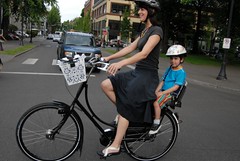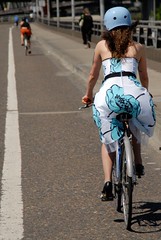
[Editor’s note: This article was originally published by Patrick Barber on his blog, Vélocouture, and has been re-published here with his permission.
On his blog, Barber writes about bike fashion with an urban flair. City bikes and fashion don’t even make news in Europe, but here in the states, they’re finally gaining serious steam (see our coverage of the Great Dutch Bike Invasion). Just yesterday, the New York Times published a piece about the popularity of high end Dutch bikes. But just what is a “city bike?” In the article below, Barber gives us his definition.]
Poke around on enough of the bike photos in the Flickrverse and you’ll start to notice something: while we North Americans ride around on all kinds of bikes . . .

. . . folks in places like Copenhagen and Amsterdam seem to have mostly the same kind of bike.

The European style of bike is what North Americans refer to as a city bike. But in Europe, and in most other parts of the world, such as Africa and China, the bike we call a city bike is simply called a “bike.” And it’s used for one thing: transportation.
“…you don’t need to make special accommodations for an aggressive posture, heavy backpacks, unwanted grease or mud, or things getting caught in moving parts. A city bike lets you dress up and go… and that’s why we love them.”
— Patrick Barber
What makes a city bike? There are lots of things we could talk about relating to its design and construction: the frame materials, steering geometry, wheel size, history of the gearing systems. But a city bike is not defined by what it is. A city bike is defined by what it does.
City bikes provide a service to the user. Like any bicycle, they help a person to move from one place to another with ease. But in addition to that basic service, city bikes help out the user in ways that a standard North American bike — say, a mountain bike or classic ten-speed — does not.
Your city bike helps keep you and your clothes tidy. You don’t need to roll up your pants when you get on a city bike. The chainguard takes care of that. You don’t need to pin up your dress or your coat — the coat guard, or skirt guard (that dark covering over the rear wheel, just behind the saddle), keeps the rear wheel from messing with your skirts. Fenders and mudflaps keep rain and road grime from splashing on your clothes and things.
Thanks to the built-in, no-battery-required generator light system, your city bike not only remembers the lights, it remembers to turn them on — and turns them off when you’re at your destination.
You don’t need to find a wall or pole to lean the bike against at your destination, you just use the kickstand.
If you need to carry something with you, just put it in the basket, or attach it to the rack. You can carry your kid, or a friend, on the back too.
Furthermore, the bike is built for maximum durability and comfort, and minimum maintenance.
This may all seem a bit much compared to the bicycles we’re used to, but consider the North American equivalent to the city bike: the private automobile. Just think of how silly it would be if you had to carry your groceries on your back when you used a car to get somewhere. Or if you wanted to go out at night, but your lights had run out of batteries. Would you buy a car that didn’t come equpped with lights to begin with, requiring you to buy separate lights that you had to attach yourself? What if a car rusted into uselessness if parked outside in the winter?
Cars, like city bikes, are designed for practical transportation.
You can spend $500, $2500, or somewhere in between to equip yourself with a brand new city bike, if you have the budget and the inclination. But you don’t need a brand new bike. With a few adjustments, the bike you ride now can likely serve you very well as a city bike — or you can cook up your own city bike from a readily-available used bike, some key parts, and a good “recipe.”
The great thing about a well-equipped city bike is that it allows you to wear whatever clothes you like — you don’t need to make special accommodations for an aggressive posture, heavy backpacks, unwanted grease or mud, or things getting caught in moving parts. A city bike lets you dress up and go… and that’s why we love them.
– You can find this original story by Patrick Barber on his blog, Vélocouture.



